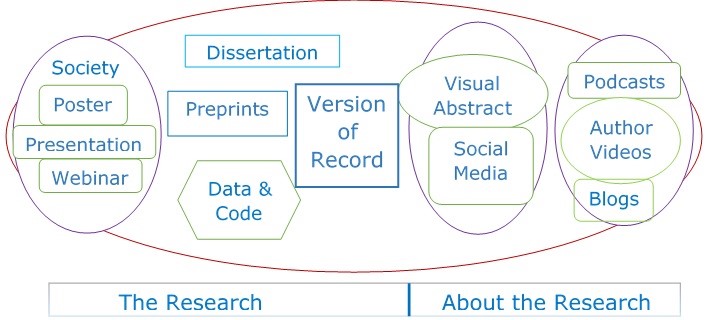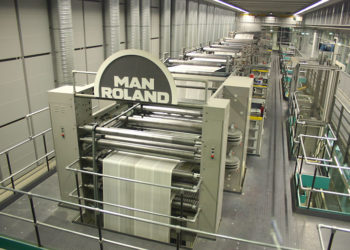Beginning with the launch of the Internet, enabling technologies have expanded the number of formats that are widely used. Images, audio, video, data, code, and other forms of digital content are common in the researcher’s workflow and have become a necessary part of scholarly communications. Meanwhile, scholarly publishing has remained predominantly page based and dependent on PDFs, though that may be about to change.

DOIs signal research content
DOIs have been associated with scholarly publishing since Crossref began providing connections between research articles in 1999. When Datacite was launched a decade later, they expanded to providing DOIs for datasets and other research objects. Then three years ago, Crossref released a schema for Preprints as the precursor to the published work. Amy Brand’s recent post in the Scholarly Kitchen noted that 87% of Crossref DOIs are assigned to journal articles and book chapters, with only 5.5% assigned to conferences. The remaining items are almost all text based works.
As a result, DOIs have primarily represented published works and data as supplemental material to the Version of Record. This signaled that research had been reviewed, curated, published, and preserved for future reference as part of the scholarly record. Given that library budgets funded these publications, preservation was an essential requirement as the digital content was no longer housed within each institution.
Born digital content expands
Recently, scholarly communications has come to refer to a variety of research outputs that are part of the scholar’s workflow beyond publications. If these works in other formats are assigned DOIs they can become part of the research universe. And with the use of standard identifiers such as ORCID for authors, and FundRef for funders, these works in different formats can be more easily discovered.
The evolving image below is a work in progress that groups types of content based on shared characteristics. From the left to the right – media connected with societies, print and data formats, media used to promote the research.

Conference Content
Most scholarly societies organize annual meetings so that scholars can discuss their work with colleagues. Originally popular in the sciences, posters have recently become very popular in other disciplines, often taking up considerable space near the exhibits. Graduate students at some institutions have deposited the image of their poster in their library’s institutional repository and then linked to it on their CV as they applied for positions. Posters have evolved from print tacked to a board to digital presentation to interactive digital presentations. They are typically up for one day and then gone. However, the digital version makes it easy to store along with a searchable abstract. Visibility increases utility – for the author, the conference attendees as well as those who did not attend and were able to discover it months after the meeting.
Conference management companies such as the Conference Exchange record presentations as audio with slides or video for societies of all sizes. Conferences with multi-track sessions can make these available to attendees who couldn’t attend both sessions or were sidetracked by a conversation and missed a session. The cost of recording can be offset in part by offering access to non-attendees for a fee. This is an opportunity to make this body of work more accessible to a global audience including many who are unable to attend. If Accessibility guidelines are adhered to, that further increases the audience by offering multiple formats. Ideally all media would be accompanied by a transcript linked to the work, though that may not be economically feasible.
New companies are emerging in our space as service providers to organizations, offering support for DOIs assigned to a much broader array of outputs. Two examples are Cadmore Media and Morressier.
- Cadmore Media states “Don’t post your videos. Publish them.” They support streaming audio and video that features advanced navigation, searching and skimming options, and support for extended metadata. Descriptive content and metadata ensures that these formats will integrate with a society’s other published works, making them more discoverable and accessible.
- Morressier states on their home page “Where research gets discovered”. They offer an abstract, poster and presentations management system designed for conference organizers. It begins with abstract management, onsite support, post meeting access, and analytics.
The idea of publishing media makes sense when we consider the review process involved in selecting presentations (or papers) and posters for meetings. In fields such as computer science and electrical engineering, the conference proceedings are more timely, and may be more important than the journals in their field. The origin of ‘publish’ is publicus or publicare in Latin which translates to ‘make public’ or ‘make generally known’. So why shouldn’t publishing expand to include media?
Potential for Societies
The opportunity for societies is to leverage an existing body of research content that has already been reviewed and made public in a time-limited way. Although it requires an additional investment, if the economics work, integrating these formats into the scholarly record could be a significant advantage for societies and associations. Some researchers may opt out for different reasons just as there are variables that affect the availability of dissertations. However, for those presenting early, partial or null results in the form of posters, saving their work will fill a gap in the research cycle where many findings that are valuable, may never be published. This is a substantial body of work that is now ephemeral in nature and could become part of the scholarly record.
A challenge for societies is that the conference software used to record, and host posters and presentations is likely in a database that functions as a silo. It will be interesting to see if conference vendors such as Confex will adapt their programs to accommodate metadata requirements or if the emerging companies will grow and expand to serve a broader association market.
Creation of a DOI for Conferences
Crossref and Datacite formed a working group last year that has defined the metadata structure for a conference DOI. It appears to be ready for a pilot stage. In the EU, the Freya Project, which is funded as part of their Horizon 2020 program, is focused on extending the infrastructure for persistent identifiers as a core component of open research. A participant in the conference metadata working group, they are seeking to disambiguate conferences, ensure that conference reviewers receive recognition for their service, improve the visibility of conferences, link papers from the same conference, and distinguish actual research conferences from those organized by predatory publishers.
Promotion of Research Content
It has become increasingly important to funders and academic research institutions that their investment in research produces results that matter to society. While only a portion of faculty will make time for a podcast, a blog, or to create a video, many more may participate in social media. Publishers can invest visual abstracts that can boost social media impact such as those created by Cactus featured on their impact.science site. Another option is videos such as though created by Research Square. Will these in time also be assigned DOIs?
Looking Ahead
While I’m not surprised that these changes are occurring, it requires an adjustment in my reference points. It feels as though the very definition of publishing is expanding to include different formats. Will it also adopt the same expectations and markers of quality? Is the same level of preservation necessary if it isn’t required by a library budget? There are many questions to be answered and many will be dependent on the economics and rewards of the stakeholders in scholarly communications.
Discussion
6 Thoughts on "Born Digital – The Expanding Universe of Research Content"
There is an aspect of DOI promulgation not mentioned here — responsibility and accountability. As you note, most DOIs from CrossRef are associated with journal articles, but the move into preprints and the use of DOIs by predatory publishers have both created cause for concern. To the latter point, CrossRef recently rescinded the membership of OMICS because it was a predatory publisher using DOIs to dupe people into believing in their legitimacy. OMICS is not the only one. DOIs are featured heavily on some predatory journal pages as a sign of legitimacy. As for preprints, why any by-definition temporary version of an article needs a permanent identifier — and can get one for less money than it costs a journal publisher — introduces other questions.
To me, CrossRef is at a crossroads. This post, cast in that light, suggests the crossroads they are facing is even more complicated. Will OMICS, the meetings company (which is what it has turned into), be able to sell meetings better because of DOIs? Will others? What level of authenticity and validity does the ability to use a DOI convey? What will a more complex information system demand of a source of legitimization?
You raise an interesting question that our industry has grappled with ever since predatory publishers emerged as a problem. There have been a variety of efforts made by organizations and individuals attempting a remedy – ISSN, DOAJ, black lists, white lists to name a few. In fact the a new DOI for Conferences could be part of the solution, depending on its implementation.
Since publishers fall on a spectrum from those who fall short of standards to those who have egregious practices, I expect that no one organization can be expected to solve this issue. It does raise the question about various entities across our industry reaching consensus on best practices for publishing that could make significant progress with this issue.
Thanks for the Post, Judy.
Much of what you talk about in moving oral and poster presentations to the digital realm is already being done by iPosterSessions (ipostersessions.com). We work with scientific, medical, and scholarly organizations like AAS, AGU, ACRL, AOA, and APSA. We provide their authors and presenters with a dynamic, multimedia, interactive publishing system in which they can include hi-res images, videos, sound files, links to dynamic datasets, simulations, visualizations, etc. They create their oral and poster presentations online, which are then displayed at their conferences on high definition touch screens. They are accessible online with any Internet-connected device. Built-in communication functions enable attendees and authors to establish and continue a dialog outside the conference venue and after the conference is over.
All content is data-based, making the system open for various metadata systems and digital identifiers. For example, AGU uses Confex and we already have a method of integrating metadata. We have also been working with ORCID and will soon be ready with a seamless integration.
As you mention, many scholarly organizations and repositories are still bound to paper and pdf. We are hoping that they will understand the increasing amount of research that is being conducted using multimedia tools, and recognize online multi-media presentations as an important part of the scientific record. The first scientific journals were published on paper over 300 years ago. It’s time to move into the digital age for both publishing and referencing.
Rick, What prompted my post is seeing these various elements of the scholars’ workflow which includes text AND data AND media – all in different silos. It seems wise to review the metadata now being collected to determine what might be most useful looking ahead. I commend you for incorporating ORCID in your workflow and see DOIs as another element that will facilitate a coherent network for a variety of stakeholders in the research environment.
Hi Judy – great summary of the developments in this area. Through Kudos Pro, we recently started offering researchers the ability to assign DOIs to project summaries (https://blog.growkudos.com/2019/03/27/kudos-and-datacite-partnership) on the basis that people
(a) wanted to have a persistent way to reference their work both during its development, (i.e. well before publication) and in cases where that work was not intended to result in a publication (e.g. performing arts), and
(b) wanted their project to benefit from the universe of tools that are structured around DOIs, e.g. altmetrics.
We had a lot of discussions, prior to developing this functionality, about the nature of publishing, and whether by assigning DOIs to project pages we were effectively becoming a publisher etc – even though the content to which we are assigning DOIs is very different to, and not necessarily related at all to, publications. I found it helpful to recall the much broader ways in which DOIs are used by other registration agencies outside the publishing sector – for example, EIDR (the Entertainment Identifier Registry) using DOIs for managing inventory e.g. assigning DOIs to movie cameras. Thinking about that kind of usage of DOIs stopped me agonising about whether assigning a DOI equals “publishing”, much less “validation”.
I agree that there are many opportunities to match their skills (editorial, curation, marketing etc) to “making public” services that are focused on media other than text. Validation / registration can be one of those services, but perhaps shouldn’t be conflated with whether or not a DOI is being assigned.
Hi Charlie, Thanks for your feedback and update on the use of DOIs for summaries. That makes sense to me. For so many years DOIs were assigned to articles and came to equated with publishing. When Preprints recently received a DOI with their own schema, I organized a session at Charleston on the Version of Record as part of adjusting my reference points for the identifier. The addition of these multiple formats, which may all have DOIs linked to the author’s ORCID at some point in the future requires adjusting my reference points for publishing being about more than text. After all it is a Digital “Object” Identifier.


